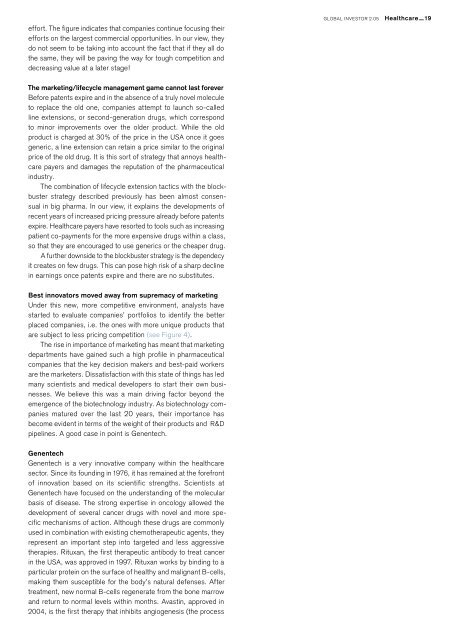Marketing and innovation
New opportunities hit global investors' radar screens Global Investor, 02/2005 Credit Suisse
New opportunities hit global investors' radar screens
Global Investor, 02/2005
Credit Suisse
You also want an ePaper? Increase the reach of your titles
YUMPU automatically turns print PDFs into web optimized ePapers that Google loves.
effort. The figure indicates that companies continue focusing their<br />
efforts on the largest commercial opportunities. In our view, they<br />
do not seem to be taking into account the fact that if they all do<br />
the same, they will be paving the way for tough competition <strong>and</strong><br />
decreasing value at a later stage!<br />
GLOBAL INVESTOR 2.05 Healthcare—19<br />
The marketing/lifecycle management game cannot last forever<br />
Before patents expire <strong>and</strong> in the absence of a truly novel molecule<br />
to replace the old one, companies attempt to launch so-called<br />
line extensions, or second-generation drugs, which correspond<br />
to minor improvements over the older product. While the old<br />
product is charged at 30% of the price in the USA once it goes<br />
generic, a line extension can retain a price similar to the original<br />
price of the old drug. It is this sort of strategy that annoys healthcare<br />
payers <strong>and</strong> damages the reputation of the pharmaceutical<br />
industry.<br />
The combination of lifecycle extension tactics with the blockbuster<br />
strategy described previously has been almost consensual<br />
in big pharma. In our view, it explains the developments of<br />
recent years of increased pricing pressure already before patents<br />
expire. Healthcare payers have resorted to tools such as increasing<br />
patient co-payments for the more expensive drugs within a class,<br />
so that they are encouraged to use generics or the cheaper drug.<br />
A further downside to the blockbuster strategy is the dependecy<br />
it creates on few drugs. This can pose high risk of a sharp decline<br />
in earnings once patents expire <strong>and</strong> there are no substitutes.<br />
Best innovators moved away from supremacy of marketing<br />
Under this new, more competitive environment, analysts have<br />
started to evaluate companies’ portfolios to identify the better<br />
placed companies, i.e. the ones with more unique products that<br />
are subject to less pricing competition (see Figure 4).<br />
The rise in importance of marketing has meant that marketing<br />
departments have gained such a high profile in pharmaceutical<br />
companies that the key decision makers <strong>and</strong> best-paid workers<br />
are the marketers. Dissatisfaction with this state of things has led<br />
many scientists <strong>and</strong> medical developers to start their own businesses.<br />
We believe this was a main driving factor beyond the<br />
emergence of the biotechnology industry. As biotechnology companies<br />
matured over the last 20 years, their importance has<br />
become evident in terms of the weight of their products <strong>and</strong> R&D<br />
pipelines. A good case in point is Genentech.<br />
Genentech<br />
Genentech is a very innovative company within the healthcare<br />
sector. Since its founding in 1976, it has remained at the forefront<br />
of <strong>innovation</strong> based on its scientific strengths. Scientists at<br />
Genentech have focused on the underst<strong>and</strong>ing of the molecular<br />
basis of disease. The strong expertise in oncology allowed the<br />
development of several cancer drugs with novel <strong>and</strong> more specific<br />
mechanisms of action. Although these drugs are commonly<br />
used in combination with existing chemotherapeutic agents, they<br />
represent an important step into targeted <strong>and</strong> less aggressive<br />
therapies. Rituxan, the first therapeutic antibody to treat cancer<br />
in the USA, was approved in 1997. Rituxan works by binding to a<br />
particular protein on the surface of healthy <strong>and</strong> malignant B-cells,<br />
making them susceptible for the body’s natural defenses. After<br />
treatment, new normal B-cells regenerate from the bone marrow<br />
<strong>and</strong> return to normal levels within months. Avastin, approved in<br />
2004, is the first therapy that inhibits angiogenesis (the process

















